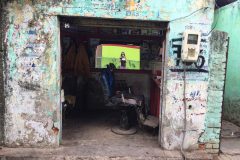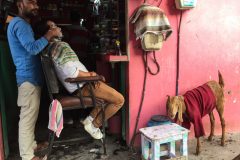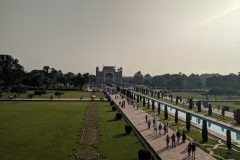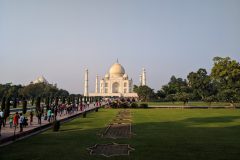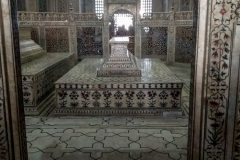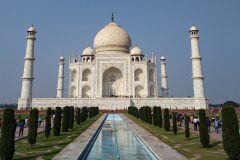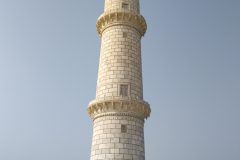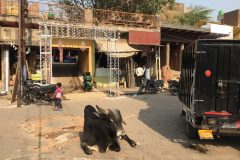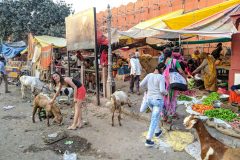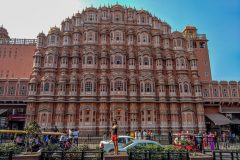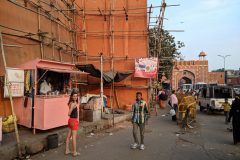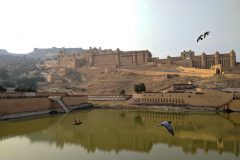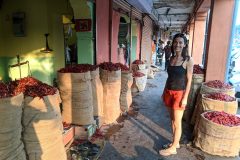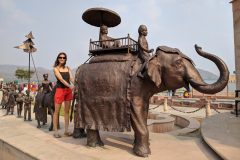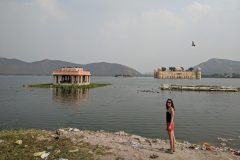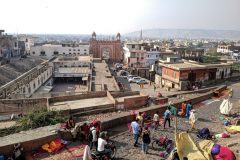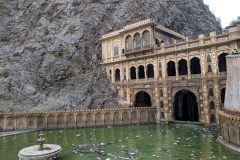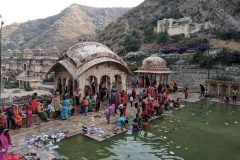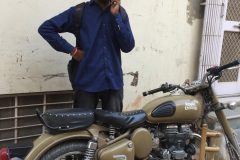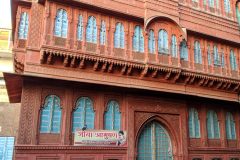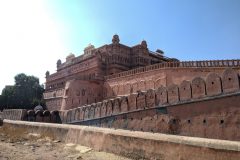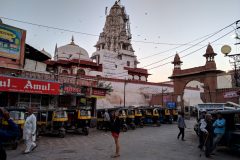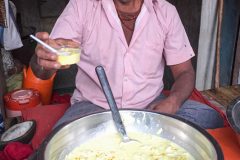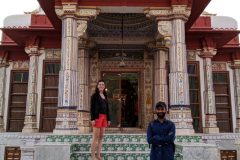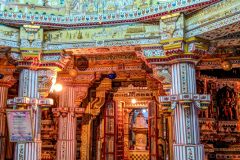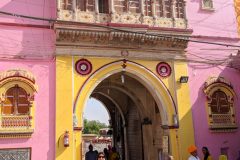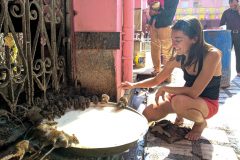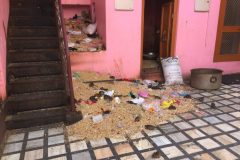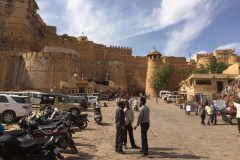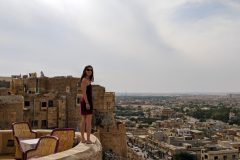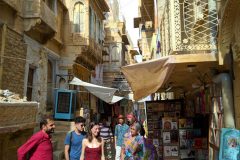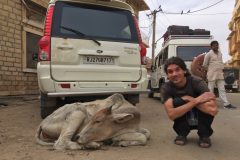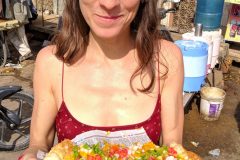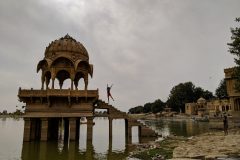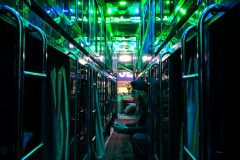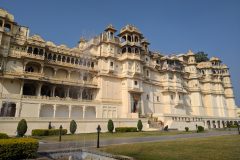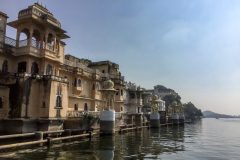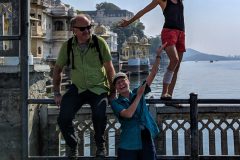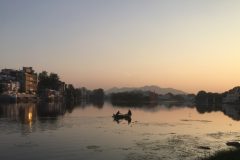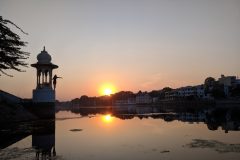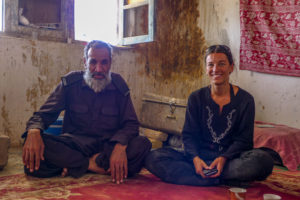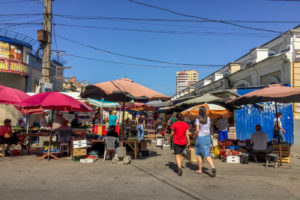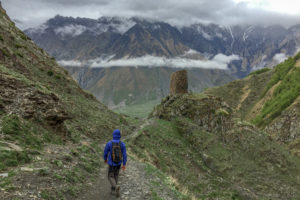It is kind of crazy – as soon as you travel without your motorcycle, you suddenly convert into an ordinary tourist. It feels like riding against a wall and from one second to another, it seems like the only contact you have with locals thenceforth, is because they want to make business with you.
The bus trip to Agra is easy, but we arrive quite late in the evening and have to organise a transfer to our hostel for the first time on that trip. Outside of the bus are already stressy taxi drivers lurking for their victims. Therefore we are not that happy, that we have to leave our bus at all. We must be looking that puzzled and lost, that a friendly local in the bus finally offers to drive us to our hostel.
Agra is world-famous for the Taj Mahal, which obviously is one of the main tourist attractions in India. Everything is focused on tourism. In case you want to explore the city on foot, it can be quite annoying to explain the reason every two minutes to approaching taxi drivers. Usually they start following you for a few hundred meters, while constantly lowering the price. However they don’t seem to understand, that people walk on purpose. As soon as they have left, the next one approaches immediately. We are always friendly, because we know, that this is how they earn their money. Nevertheless it is quite exhausting to handle it the whole day.
Tourist prices in India are typically a multiple compared to the local ones. That’s quite common in Asia though. It includes everything without a fix price, but also state related institutions like National Parks and other sights. Taj Mahal is also one of them. A ticket for locals is 0,60€ and for foreigners it is 13,60€. If you want to see the mausoleum’s interior, it costs an extra of 2,50€. Being faced with such a price difference, we are already about to cancel our visit. Some people might think, that these local prices are to give India’s poor population the possibility to visit the sights. This sounds great in theory, but in reality the only locals you see there, are probably earning more money than most of the tourists. But – you actually can’t be in Agra without visiting Taj Mahal. So I convinved Miriam to see it at least ones in her lifetime.
The next morning we walk to Taj Mahal’s entrance and we pass a busy market area with many tiny alleys, stuffed with all sorts of goods. It is really chaotic and there seem to be no tourists at all. We can only get along slowly, but it is nice to watch all that going-on.
When we arrive at Taj Mahal’s main entrance, it is closed. Sombody tells us, that we have to use one of the side entrances. It is World Heritage Week and since it is extremely full, the main entrance was closed. But – we are lucky – the admission is free today.
Of course, there is always a massive hype about sights. Somebody might remember our sobering report, when we visited Greek’s famous Delphi. Taj Mahal is different though – it is really fantastic. The splendid park area in the beginning and the massiv, white marble structure, covered with mosaic all over, is absolutely unique. If you imagine, how hard it is to work on marble, it is even more impressive.
As already mentioned before, it is extremely busy, but we still take a few minutes to get squeezed though the mausoleum’s internal. Although there are a few signs, that taking photos is prohibited, nobody seems to care. Not even the guards, that are working to push the crowd as fast as possible towards the exit again, seem to care about everybody using their cameras. The internal is ok, but not really worth paying 2,50€ extra on normal visitor days.
Most of the people in India have smartphones these days and they are almost as selfie-addicted as the people in Iran and Pakistan. After a few minutes I already can’t remember anymore, how many selfies we have been taking so far. To my great delight, Miriam has to hold Indian babies every once in a while. Their eyes are usually framed with thick eye shadow to make them appear bigger and the babies sweeter. Miram has to pose with them in front of the Taj Mahal, that the parents can take some photos. She is always standing there as stiff as a poker, while I have a hearty laugh in the background. Every person, that knows Miriam a bit closer, would have shared my pleasure for sure.
The next day we take an overnight bus to Jaipur, Rajasthan’s capital. Rajasthan is India’s desert state and looks a bit similar to Uzbekistan and Iran. The landscape is also not that interesting – so the focus is mainly on city tours. Bablaa from Lucknow gave us a contact to the local bikers and they picked us up at the bus terminal and organised a nice hostel for us. In the evening we join them at a special restaurant, that is run by deaf-mutes and they serve some great local dishes.
Indian cuisine is as special as the country itself. Either you love it or you are only little enthusiastic. Most of the dishes include a lot of spices and are usually rather hot. Unfortunately there is one spice, Miriam doesn’t really like and it is almost in every dish. So Miriam is not that into Indian cuisine – I like it a lot though.
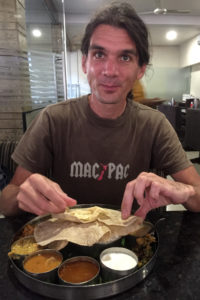
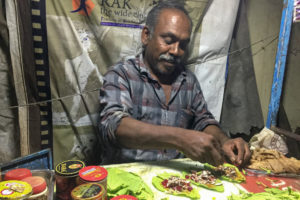
India has probably the biggest amount of vegetarians in this world and the dishes are extremely varied. Even as a non-vegetarian, you aren’t missing any meat. Very special is also the Indian Masala Chai. It is a milk tea, made with ginger, cinnamon, cloves etc. and Miriam likes it, too. In addition to that, she likes another Indian specialty called Pan. Pan is a mouth refresher and usually used after a meal or just in between. Pan shops are often tiny little huts, just as big, that one person can fit in there. There is an extremely strong tobacco version and a sweet version without tobacco. Pan is made out of one or even more betel leaves. They are filled with e.g. a special brown sauce, fennel seeds, candied fruits, a sort of jam, various sugar coated spices, rose water, betel nuts and plenty of other stuff. Pan differs from region to region and you can also order it individually, as far as you can explain it to the vendor with the language barrier. It is an explosion of flavours and there is nothing comparable in Europe. Trying Pan is a must, if you travel to India – it is just something typical Indian. In Jaipur they even sell Pan shakes and Pan ice cream.
On our city tour the next day, we even find the most famous Pan shop in Jaipur. The owner is called Baba Pan and he prepares an extra special Pan for us, that is almost too big to fit in our mouths.
India’s cities are full of sacred cows, that chill or walk around everywhere. You can find them in the middle of the road in an absolute traffic chaos, on the highway, on the beach, on the market, in a temple – just everywhere. They are very relaxed and usually don’t care about ear-battering honking. You can also pet them pretty well, what Miriam likes a lot. In Jaipur’s traffic it is also not unusual to find camels and elephants.
We explore most of Jaipur’s sights, but usually only the outsides. That is completely adequate for us, since paying for all the admissions, would be easily more than 50€. We visit the Palace of the Winds (Hawa Mahal), Jal Mahal Palace at the Man Sagar lake and we take the public bus to Amber Fort. Afterwards we stroll a bit through the small alleys and, quite common for this region, get invited to buy jewellery. Although you try to clarify the vendors, that you are not willing to buy anything, they make you to enter their stores. “Just looking, just looking”. So you continue to clarify, that you definitely won’t buy any jewellery, while they start to present more and more stuff. It always takes a while, until they let you go again a bit disappointed. You can’t really blame them, since they are only doing their jobs and there are plenty of competitors. However, in the end of the day you feel quite exhausted every time.
The next day we go for a little hike to the Hanuman Ji Temple, which is situated a bit outside of the city. On the way up to the temple, some locals present sacred, malformed cows, that have additional extremities grown out on their bodies. It looks a bit odd, but it wouldn’t be India without things like that. The temple is in the next valley and full of monkeys. It includes two pools, where people take a bath in the sacred water. It is interesting to watch, but full of garbage, although it is a sacred place.
In the evening one of our biker friends invites us for dinner to his home. This is always really cool, because you get usually served different food, that is not always available in the common street snacks. Afterwards they show us another part of the city, before our last night in Jaipur comes to its end. The next morning we continue to Bikaner.
Bikaner once was a busy trading town, when India and Pakistan still were one country. Nowdays it is just a trivial city in the middle of nowhere, where even tourists are rare. Our biker friends gave us another local biker contact and Raju is so nice to show us around in his hometown.
After a few kilometers with all three of us on his bike, we face a prime example for Indian traffic. We arrive at a railroad crossing with shut barriers, since a train is about to pass by soon. Obviously it causes a traffic jam on both sides and people start to honk like crazy – as if this would accelerate the process. Many locals are still busy to squeeze their little scooters through the barriers to reach the other side before the train comes. Most of the scooters are too high though, so they often fall over and the owners become a bit nervous. Everybody wants to be the first and the crush is just insane. This results in jammed traffic lanes on each side – both the oncoming lane and on both sides of the railroad crossing. When the barriers finally open, nobody can move anymore – what a surprise? Obviously it takes ages till the situation is cleared again. The honking is almost unbearable and the whole situation is just unbelievable. It is like finding yourself in a crazy horde of monkeys, where the most important control on their vehicle is the horn – absolutely indescribable.
Bikaner actually is famous for its splendid Havelis. These are palatial residential buildings, that were built by the rich salesmen back then. After India and Pakistan had divided, most of the salesmen left. Many of these beautiful buildings are empty now and they get sold or even tore down. Unfortunately, the historical value and also the value for potential tourism in future, hasn’t come to the locals mind yet. Bikaner also has a beautiful fort and some nice temples.
The next day we go for a day trip to Deshnoke to visit the unique Karni Mata rat temple. Sacred rats is also something, you can probably only find in India. The building itself is not that spectacular, but the fact, that thousands of rats are living, are fed and venerated there, is pretty special. Everywhere is food an bowls of milk for the little rodents.
After breakfast the next morning we take a bus to the desert city Jaisalmer. After the division of India and Pakistan it has become a full tourism town in a very remote area. The old town is in a fort on top of a hill and surrounded by a massive wall. In the course of time the new city has grown outside of the fort. Jaisalmer is the nicest city in Rajasthan in our opinion. The old town consists of many small alleys with splendid Havelis and temples. It feels like in a persian fairytale.
Despite the amount of tourists, it is a relaxed place. As soon as the sun goes down, there is nothing going on anymore and it is pleasant calm. A big thing here are jeep tours and camel safaries with overnight stays in the desert. It is nothing really for us though, since the prices are very high and we have already slept many days in deserts anyway. Why should we spend money on that? We rather visit Gadsisar lake and chill around the nice pavillons there. The lake is surrounded by a desert and its water comes from the Himalayan rivers by an impressive construction of an artificial canal. In the evening we take an overnight bus to Udaipur.
The road to Udaipur is rough and we feel like sleeping in a roller coaster in our little sleeping cabin. As soon as you sit up, the chance is very high to hit your head against the cabin’s ceiling. Therefore we feel a bit tired when we arrive, after a night with so much “air time”. We decide to relax a bit in a cosy hostel during the day. In the evening we meet our ex-boss Joachim with his wife in a nearby hotel. We knew in advance, that they will be in Udaipur and agreed to meet a few days ago. It is hard to believe, that we are already on the road for 9 months.
The next day we meet to visit Udaipur’s city palace. The museum gives some nice impressions of the life in these days and a beautiful view of Udaipur an the surrounding lakes. Afterwards we still stroll though a garden park for a while. Joachim’s and Heike’s driver wants to show us an amazing spot for sunset on top of a local hill. Unfortunately the Indians have decided to charge for admission now. The crazy ticket price for foreigners finally precludes us to go there. We rather invest some money for beer and wine and watch the sunset at the lake.
After breakfast the next morning we go separate ways again and we take an overnight bus to Mumbai.

